|
|
 |
|
Calanoida ( Order ) |
|
|
|
Calanoidea ( Superfamily ) |
|
|
|
Paracalanidae ( Family ) |
|
|
|
Paracalanus ( Genus ) |
|
|
| |
Paracalanus nanus Sars, 1907 (F,M) | |
| | | | | | | Ref.: | | | Sars, 1907 (p.4, Rem.F); 1925 (p.26, figs.F); Sewell, 1929 (p.71, figs.F); Rose, 1933 a (p.75, figs.F); Tanaka, 1960 (p.24, figs.F,M); Shmeleva, 1964 a (p.1068); Corral Estrada, 1970 (p.91, figs.F,M); Razouls, 1972 (p.94, Annexe: p.19, figs.F); (p.9); Chen & Zhang, 1974 (p.105, figs.F,M); Andronov, 1977 (p.155, fig.F); Bradford, 1978 (p.134: Rem.); Björnberg & al., 1981 (p.604, 622, figs.F,M); Hiromi, 1987 (p.153); Nishida, 1989 (p.173, table 1, 2, dorsal hump); Bradford-Grieve & al., 1999 (p.878, 910, figs.F,M); Avancini & al., 2006 (p.65, Pl. 34, figs.F,M, Rem.); Vives & Shmeleva, 2007 (p.970, figs.F,M, Rem.); Kesarkar & Anil, 2010 (Rem.: p.404, fig.F) |  issued from : J. Corral Estrada in Tesis Doct., Univ. Madrid, A-129, Sec. Biologicas, 1970. [Lam.18, figs.7-13]. Female (from Canarias Is.): 7, P1; 8, P2; 9, P3; 10, P4; 11, P5; 12, forehead (lateral); 13, posterior part cephalothorax with P5 and urosome (lateral left side).
|
 issued from : J. Corral Estrada in Tesis Doct., Univ. Madrid, A-129, Sec. Biologicas, 1970. [Lam.19]. Male: 1, habitus (dorsal); 2, idem (lateral right side); 3, P1; 4, P2; 5, P3; 6, P4; 7, P5. Female (another specimen): 8, forehead (lateral); 9, P5.
|
 issued from : R.B.S. Sewell in Mem. Indian Mus., 1929, X. [p.71, Fig.26]. Female (from Nicobar Is.): a, habitus (lateral left side); b, A2; c, P2; d, P3; e, P4; f, P5.
|
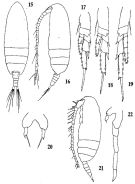 issued from : Q.-c. Chen & S.-z. Zhang in Studia Marina Sinica, 1974, 9. [Pl.2, Figs.15-22]. Female (from South China Sea): 15, habitus (dorsal); 16, idem (lateral left side); 17, P2; 18, P3; 19, P4; 20, P5. male: 21, habitus (lateral left side); 22, P5.
|
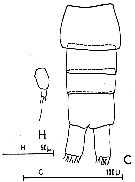 issued from : C. Razouls in Th. Doc. Etat Fac. Sc. Paris VI, 1972, Annexe. [Fig.26, C, H]. Female (from Banyuls, G. of Lion): C, urosome (dorsal); H, P5.
|
 issued from : K.S. Kesarkar & A.C. Anil in J. mar. Biol. Ass. UK, 2010, 90 (2); [p.404, Table 2]. Characteristics of females.
|
 issued from : K.S. Kesarkar & A.C. Anil in J. mar. Biol. Ass. UK, 2010, 90 (2); [p.407, Fig.5, G]. Female: G, P5.
|
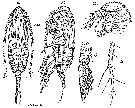 Issued from: G.O. Sars in Résult. Camp. Scient. Prince Albert I, 69, pls.1-127 (1924). [Pl.VI, figs. 10-13]. Female: 10, habitus (dorsal); 11, idem (lateral, left side); 12, forehead (lateral); 13, distal segments of A1.
|
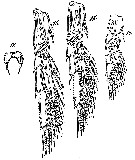 Issued from: G.O. Sars in Résult. Camp. Scient. Prince Albert I, 69, pls.1-127 (1924). [Pl.VI, figs. 14-17]. Female: 14, P1; 15, P2; 16, P3; 17, P5.
|
 Issued from : O. Tanaka in Spec. Publs. Seto mar. biol. Lab., 10, 1960 [Pl. VII]. Female (from 18°54'S, 60°39'E): 1,habitus (lateral); 2, head (dorsal); 3, abdomen (dorsal); 4, genital segment (ventral); 5, P1; 6, P2; 7, P3; 8, P4; 9, P5. Nota: Cephalothorax and abdomen in the proportional lengths 78 to 22. Head and 1st thoracic segment fused, 4th and 5th thoracic segments fused. Frontal margin of the head narrowly rounded in dorsal aspect but it is obtusely rounded and the outline is rather straight at the apical portion in lateral aspect. Posterior thoracic margin furnished with short hairs. Rostrum composed of 2 strong and slightly curved spines. Abdomen 4-segmented; abdomen and caudal rami in the proportional lengths 32 : 12 : 14 : 22 : 20 = 100. Genital segment produced moderately below; the receptacle long and extends more than half the width of the segment when viewed from the lateral. Caudal rami 2 times as long as wide. A1 25-segmented, extends about to the distal margin of the 3rd abdominal segment. P1: exopod 3-segmented, endopod 2-segmented. coxa with a strong spine near the outer distal corner of the segment; basis with a longitudinal row of spinules along the outer margin; 1st exopodal segment with on the inner margin a lateral swelling which is furnished with stiff hairs. P2 to P4 , each with exopod and endopod 3-segmented. P2 with 7 spinules on the proximal outer margin and 1 spinule on the distal outer margin of the 3rd exopodal segment; 2nd exopodal segment with a leaf-like spine near the base of the outer edge spine; 1st exopodal segment with a row of leaf-like spines. P3 with 10 spihules on the proximal, and 2 spinules on the distal outer margin of the 3rd exopodal segment. P4 with 11 spinules on the proximal outer margin of the 3rd exopodal segment; the leaf-like spines absent on the 2nd exopodal segment. P5 2-segmented, small; the distal segment with 2 spines of which the outer marginal one is very short. Male: 10, last thoracic segment and abdomen (lateral). Nota: Cephalothorax and abdomen in the proportional lengths 76 to 24. There is a transparent swelling on the mid-dorsal line about the opposite position to the base of the A1. The ventro-lateral margin of the last thoracic segment without short hairs. Abdomen 5-segmented.; segments and caudal rami in the proportional lengths 13 : 20 : 15 : 15 : 15 : 22 = 100. The 2nd to 4th segments striated with fine spinules on the distal margin. P1 to P4 as in female. Right P5 2-segmented and short, distal segment with 2 apical spines. Left P5 long, extends beyond the end of the caudal rami; 4th segment terminates into a spine; 5th segment with 2 apical spines of which the outer marginal one is small. Immature male: 11, last thoracic segment and abdomen (lateral).
|
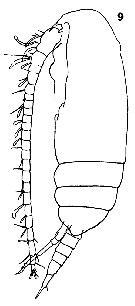 Issued from : O. Tanaka in Spec. Publs. Seto mar. biol. Lab., 10, 1960 [Pl. VIII, 9]. Male: 9, habitus (lateral).
|
 Issued from : O. Tanaka in Spec. Publs. Seto mar. biol. Lab., 10, 1960 [p.25 ]. Female: Proportional lengths of segments of A1. Nota: A1 23-segmented, extends about to the distal margin of the anal segment. Segments 1 and 2, 3 and 4 fused.
|
 Issued from : V.N. Andronov in Russian Acad. Sci. P.P. Shirshov Inst. Oceanol. Atlantic Branch, Kaliningrad, 2014. [p.73, Fig.19: 15 ]. Paracalanus nanus after Andronov, 2014. Male P5.
| | | | | Compl. Ref.: | | | Sewell, 1948 (p.323, 431, 469); C.B. Wilson, 1950 (p.275); Grice & Hart, 1962 (p.287, 293: Rem.); Gaudy, 1962 (p.93, 99, Rem.: p.103); V.N. Greze, 1963 a (tabl.2); Shmeleva, 1963 (p.141); De Decker & Mombeck, 1964 (p.13); Grice & Hulsemann, 1965 (p.223); Shmeleva, 1965 b (p.1350, lengths-volume-weight relation); Mazza, 1966 (p.69); Furuhashi, 1966 a (p.295, vertical distribution in Kuroshio region, Table 10); Pavlova, 1966 (p.43); Grice & Hulsemann, 1967 (p.14); Delalo, 1968 (p.137); Dowidar & El-Maghraby, 1970 (p.269); Deevey, 1971 (p.224); Apostolopoulou, 1972 (p.327, 337); Corral Estrada & Pereiro Muñoz, 1974 (tab.I); Carter, 1977 (1978) (p.35); Porumb, 1980 (p.168); Vives, 1982 (p.290); Kovalev & Shmeleva, 1982 (p.82); Scotto di Carlo & al., 1984 (1043); Guangshan & Honglin, 1984 (p.118, tab.); Regner, 1985 (p.11, Rem.: p.24); Brinton & al., 1986 (p.228, Table 1); Madhupratap & Haridas, 1986 (p.105, tab.1); Lozano Soldevilla & al., 1988 (p.57); Oliveira Dias, 1995 (p.147); Shih & Young, 1995 (p.71); Go & al., 1997 (tab.1); Siokou-Frangou, 1997 (tab.1); Hure & Krsinic, 1998 (p.100); Suarez-Morales & Gasca, 1998 a (p.110); Noda & al., 1998 (p.55, Table 3, occurrence); Mauchline, 1998 (tab.58); Holmes, 2001 (p.39); Hwang & al., 2003 (p.193, tab.2); Paffenhöfer & Mazzocchi, 2003 (p.1151, fig.8); Vukanic, 2003 (139, tab.1); Lo & al.*, 2004 (p.218, tab.1, fig.6); Lo & al., 2004 (p.89, tab.1); Isari & al., 2006 (p.241, tab.II); Hwang & al., 2006 (p.943, tabl. I) ; Dias & Araujo, 2006 (p.62, Rem., chart); Hwang & al., 2007 (p.24); Dur & al., 2007 (p.197, Table IV); Khelifi-Touhami & al., 2007 (p.327, Table 1); Selifonova & al., 2008 (p.305, Tabl. 2); McKinnon & al., 2008 (p.844: Tab.1); Lan Y.-C. & al., 2008 (p.61, Table 1, % vs stations); Tseng L.-C. & al., 2008 (p.153, Table 2, fig.5, occurrence vs geographic distribution, indicator species); Raybaud & al., 2008 (p.1765, Table A1); Gusmao & McKinnon, 2009 (p.1101, sex ratios); Lidvanov & al., 2010 (p.356, Table 3); Cornils & al., 2010 (p.2076, Table 3, Fig.5); Schnack-Schiel & al., 2010 (p.2064, Table 2: E Atlantic subtropical/tropical); Mazzocchi & Di Capua, 2010 (p.426); Maiphae & Sa-ardrit, 2011 (p.641, Table 2, 3, Rem.); Magris & al., 2011 (p.260, abundance, interannual variability); Tseng L.-C. & al., 2011 (p.239, Table 3, abundance %); Tseng L.-C. & al., 2011 (p.47, Table 2, occurrences vs mesh sizes); Kâ & Hwang, 2011 (p.155, Table 3: occurrence %); Selifonova, 2011 a (p.77, Table 1, alien species in Black Sea); Andersen N.G. & al., 2011 (p.71, Fig.3: abundance); Mazzocchi & al., 2011 (p.1163, Table II, fig.6, long-term time-series 1984-2006); Isari & al., 2011 (p.51, Table 2, abundance vs distribution); Mazzocchi & al., 2012 (p.135, annual abundance 1984-2006); Shiganova & al., 2012 (p.61, Table 4); Uysal & Shmeleva, 2012 (p.909, Table I); Salah S. & al., 2012 (p.155, Tableau 1); Gubanova & al., 2013 (in press, p.4, Table 2); in CalCOFI regional list (MDO, Nov. 2013; M. Ohman, comm. pers.); Tseng & al., 2013 (p.507, seasonal abundance); Lidvanov & al., 2013 (p.290, Table 2, % composition); Terbiyik Kurt & Polat, 2013 (p.1163, Table 2, seasonal distribution); Hwang & al., 2014 (p.43, Appendix A: seasonal abundance); Bonecker & a., 2014 (p.445, Table II: frequency, horizontal & vertical distributions); Zaafa & al., 2014 (p.67, Table I, occurrence); Mazzocchi & al., 2014 (p.64, Table 3, 4, 5, spatial & seasonal composition %); Rojas-Herrera & al., 2016 (p.40, Table 2: temporal abundance); Benedetti & al., 2016 (p.159, Table I, fig.1, functional characters); El Arraj & al., 2017 (p.272, table 2, spatial distribution); Benedetti & al., 2018 (p.1, Fig.2: ecological functional group); Belmonte, 2018 (p.273, Table I: Italian zones); Chaouadi & Hafferssas, 2018 (p.913, Table II, III, fig.4, 5: occurrence, abundance, seasonal variation). | | | | NZ: | 14 | | |
|
Distribution map of Paracalanus nanus by geographical zones
|
| | | | | | | | | | | |  issued from : A.A. Shmeleva in Bull. Inst. Oceanogr., Monaco, 1965, 65 (n°1351). [Table 6: 8 ]. Paracalanus nanus (from South Adriatic). issued from : A.A. Shmeleva in Bull. Inst. Oceanogr., Monaco, 1965, 65 (n°1351). [Table 6: 8 ]. Paracalanus nanus (from South Adriatic).
Dimensions, volume and Weight wet. Means for ca. specimens. Volume and weight calculated by geometrical method. Assumed that the specific gravity of the Copepod body is equal to 1, then the volume will correspond to the weight. |
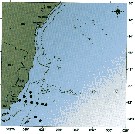 issued from : C. de O. Dias & A.V. Araujo in Atlas Zoopl. reg. central da Zona Econ. exclus. brasileira, S.L. Costa Bonecker (Edit), 2006, Série Livros 21. [p.62]. issued from : C. de O. Dias & A.V. Araujo in Atlas Zoopl. reg. central da Zona Econ. exclus. brasileira, S.L. Costa Bonecker (Edit), 2006, Série Livros 21. [p.62].
Chart of occurrence in Brazilian waters (sampling between 22°-23° S).
Nota: sampling 34 specimens. |
| | | | Loc: | | | South Africa (E), Namibia, SW Atlant., off Morocco-Mauritania, Cap Ghir, Canary Is., off Madeira, Azores Is., Brazil (off Rio de Janeiro, off Vitoria-Cabo de Sao Tomé, Mucuri estuary), off Bermuda, W Ireland (Mutton Is.), off W Tangier, Medit. (M'Diq, Alboran Sea, Habibas Is., Sidi Fredj coast, Gulf of Annaba, Banyuls, Marseille, Ligurian Sea, Tyrrhenian Sea, G. of Napoli, Strait of Messina, Adriatic Sea, Ionian Sea, Aegean Sea, Thracian Sea, Iskenderun Bay, Lebanon Basin, Alexandria, Black Sea), Red Sea, Natal, Indian (W & SW), Nicobar Is., G. of Thailand, SW Celebes, Philippines, Pacif. (W equatorial), Australia (North West Cape), China Seas (East China Sea, South China Sea, E Kuroshio Current,), 25°30'N-122°30'E, Taiwan (S, SW, N: Mienhua Canyon, Danshuei Estuary, NE), Okinawa, S Japan (Kuchinoerabu Is.), California, Gulf of California, Acapulco Bay (frequent). | | | | N: | 89 | | | | Lg.: | | | (1) F: 0,6; (29) F: 0,62; (66) F: 0,6; M: 0,57; (180) F: 0,65-0,6; M: 0,6-0,57; (338) F: 0,63-0,5; M: 0,53-0,5; (1047) F: 0,52; {F: 0,50-0,65; M: 0,50-0,60}
The mean female size is 0.590 mm (n = 8; SD = 0.526) and the mean male size is 0.554 mm. The size ratio (male : female) is more or less near of 0.739. | | | | Rem.: | epi-mesopelagic. Mainly neritic.
After Benedetti & al. (2018, p.1, Fig.2) this species belonging to the functional group 4 corresponding to small filter feeding herbivorous and mixed feeding omnivorous (mostly broadcasters). | | | Last update : 28/10/2022 | |
|
|
 Any use of this site for a publication will be mentioned with the following reference : Any use of this site for a publication will be mentioned with the following reference :
Razouls C., Desreumaux N., Kouwenberg J. and de Bovée F., 2005-2025. - Biodiversity of Marine Planktonic Copepods (morphology, geographical distribution and biological data). Sorbonne University, CNRS. Available at http://copepodes.obs-banyuls.fr/en [Accessed December 12, 2025] © copyright 2005-2025 Sorbonne University, CNRS
|
|
 |
 |















